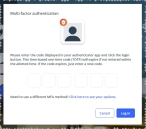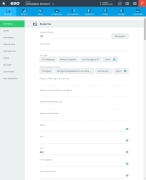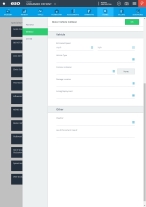Motor vehicle collision
A motor vehicle collision occurs when a vehicle collides with another vehicle, pedestrian, animal, road debris, or other stationary obstruction, such as a tree, pole or building. Traffic collisions often result in injury, disability, death, and property damage, as well as financial costs to both society and the individuals involved. A number of factors contribute to the risk of collisions, including vehicle design, speed of operation, road design, weather, road environment, driving skills, impairment due to alcohol or drugs, and behavior, notably aggressive driving, distracted driving, speeding and street racing.
-
 (If you have not done so already) Access the EHR module in the ESO Suite.
(If you have not done so already) Access the EHR module in the ESO Suite.
-
Do one of the following.
-
(If you are already working in the ESO Suite) Click the Home icon in the upper left corner of the screen.
-
 (If you have not yet logged in) Log in to the ESO Suite.
(If you have not yet logged in) Log in to the ESO Suite.
-
In a web browser, go to https://www.esosuite.net/EsoSuite.
The ESO Suite login screen appears.
-
Enter your user name, password, and agency name, then click Let's Go.
If MFA is enabled, the Multi-factor authentication dialog box appears, displaying one or more methods you can use to verify your login credentials. The number of methods that appear in the dialog box depends on what MFA methods your ESO Suite administrators enabled in the Admin module.

Click graphics
to open them.Information on enabling MFA and specific MFA methods is available in the Admin module online help, in Configure multiple-factor authentication.
Note: If your ESO Suite administrators have disabled MFA ("opted-out"), this dialog does not appear.
-
(If the Multi-factor authentication dialog box appears) Depending on which buttons appear in the dialog box, verify your login in one of the following ways.
 With an authenticator application.
With an authenticator application.
-
Click MFA verification via authenticator app.
The dialog box updates with boxes for entering the numbers of the authentication code, and the ESO Suite sends an authentication code to the authenticator application installed on your device.
-
Open your authenticator application and note the authentication code currently displayed.
-
Enter the authentication code displayed in the authenticator application.
-
Click Log In.
 With a text message (SMS).
With a text message (SMS).
-
Click MFA verification via SMS.
The dialog box updates with boxes for entering the numbers of the authentication code, and the ESO Suite sends an authentication code to the phone number recorded in your PM records and identified with MFA codes.
-
Enter the authentication code sent to your MFA-registered phone number.
-
Click Log In.
 With an email message.
With an email message.
-
Click MFA verification via email.
The dialog box updates with boxes for entering the numbers of the authentication code, and the ESO Suite sends an authentication code to your agency or department email address, recorded in your PM records.
-
Enter the authentication code sent to your agency or department email address.
-
Click Log In.
-
-
The ESO Suite landing screen appears.

Click graphics
to open them.Note: If MFA is enabled, you can access and manage your MFA options through the PM module, on the Settings > Account page, as described in Manage a user account. If your agency or department has enabled MFA but has not purchased the full-featured version of the PM module, you can access your own MFA settings by clicking Change my Multi-Factor Authentication settings on the landing screen, then using the Settings > Account page that appears. If your agency has not enabled MFA, the Change my Multi-Factor Authentication settings link does not appear on the landing screen.
-
-
On the top side of the home screen, click EHR.
Tip: If your screen or browser window is too narrow to display all your agency's ESO Suite module icons, an options icon appears on the right side of the icon bar. If you click the options icon, a menu appears containing additional module icons.
The EHR screen appears, displaying a list of patient records in the EHR module. The most-recent records appear at the top of the list.
Different record status icons can appear in the list.
Icon Status Unlocked/DraftThe patient record exists in the ESO Suite database, and all crew members listed in the patient record may edit all fields in the record. ESO Suite administrators and personnel with security roles of either
EHR SupervisororEHR Managercan edit non-clinical fields.MobileThe patient record exists on the mobile device, and has not been synchronized with the ESO Suite database. ESO Suite administrators, personnel with security roles of either
EHR SupervisororEHR Manager, and all crew members listed in the patient record can only access a print view of the record.Once the Mobile record synchronizes with the ESO Suite database. the record reflects its current status.
LockedThe patient record exists in the ESO Suite database, and is locked. Only non-clinical fields can be edited by crew members listed in the patient record, ESO Suite administrators and personnel with security roles of either
EHR SupervisororEHR Manager.
-
-
 (If you have not done so already) Add a new patient record, or search for the existing patient record you want to work with.
(If you have not done so already) Add a new patient record, or search for the existing patient record you want to work with.
Information on adding or opening a patient record is available in Add a patient record and Search for a patient record.
The patient record opens and displays the Incident tab, with the Response bookmark selected in the left pane. Fields appear in the right pane for specifying basic information about the incident
If you manually created a new patient record, the Incident Number and State Tracking Number fields populate automatically with ESO Suite-assigned values. You must enter data in all other required fields.
If you imported data from a CAD system, the Incident Number field populates with the data from that source. Other fields in the EHR module may also populate from these sources, depending on what data was recorded in them before the data was imported into the EHR module.
-
At the top of the page, click the Forms tab.
The contents of the Forms tab appear, listing all the forms your ESO Suite administrator has enabled in the Admin module.
-
Click Motor Vehicle Collision.
The Motor Vehicle Collision dialog box appears, with the Patient bookmark selected in the left pane.
-
 Collect patient crash details.
Collect patient crash details.
-
For Patient Injured, click Yes or No to indicate whether the patient suffered any physical trauma from the collision.
-
For the following fields, click the field or the list icon to the right of the field, then select the appropriate single option from the menu that appears to pinpoint the patient's location n the vehicle.
Field Information needed Position in Vehicle
The patient's position in or on the exterior of the vehicle.
Example: Front seat, middle, third row right side, sleeper section of a semi truck, motorcycle passenger
Seat Row
The number of the seat row the patient was seated in, particularly in mass-transit vehicles, such as buses.
-
For Safety Devices Used By Patient, click None, or click the list icon to the right of the field, select all the appropriate options from the menu that appears, then click OK or click outside the menu to indicate what, if any, passenger restraint systems the patient was using when the collision occurred.
Example: Shoulder and/or lap belt, child booster seat, infant seat, helmet, eye protection
-
For Extrication Required, click Yes or No to indicate whether the patient suffered any physical trauma from the collision.
Vehicle extrication is the process of removing a vehicle from around a person who has been involved in a motor vehicle crash, when conventional means of exit are impossible or inadvisable due to injuries suffered. This operation is usually accomplished by using chocks and bracing for stabilization and powered rescue tools and equipment, including hydraulic rescue tools in vehicle accidents, such as cutters, spreaders, and rams.
If you click Yes, the Extrication Comments, Extrication Time, and Date fields appear.
-
 (If you clicked Yes) Provide details about the extrication.
(If you clicked Yes) Provide details about the extrication.
-
In Extrication Comments, type additional information about how the extrication affected the patient and how the extrication was performed.
-
For Extrication Time, click the number pad icon to the right of the field, then enter the appropriate numerical values from the number pad dialog box that appears for the time the rescuers performed the vehicle extrication.
-
For Date, click the calendar icon on the right end of the field and select the appropriate date from the calendar that appears for the date the rescuers performed the vehicle extrication.
-
-
-
 Describe the vehicle and its damage from the collision.
Describe the vehicle and its damage from the collision.
-
In the left pane, click the Vehicle bookmark.
The right pane scrolls down to the top of the Vehicle section of the page.
-
For Estimated Speed, in the one of the mph or kph fields, click the number pad icon to the right of the field, then enter the appropriate numerical values from the number pad dialog box that appears for the speed of the vehicle the patient was in at the time of the collision.
The EHR module automatically converts the speed you entered into the other measurement system as well, and displays the values in both fields.
-
For Vehicle Type, click the field or the list icon to the right of the field, then select the appropriate single option from the menu that appears to describe the general category of the vehicle the patient was in or on during the collision.
Example: Aircraft, automobile, motorcycle, snowmobile, semi truck (tractor-trailer)
-
For Collision Indicator, click None, or click the list icon to the right of the field, select all the appropriate options from the menu that appears, then click OK or click outside the menu to identify the indicators of the crash mechanism of injury.
Example: Ejection, intrusion distance into the patient's occupant compartment, EMS provider's judgment
-
For Damage Location, click the list icon to the right of the field, select all the appropriate options from the menu that appears, then click OK or click outside the menu to indicate where damage occurred to the vehicle during the collision.
-
For Airbag Deployment, click the field or the list icon to the right of the field, then select the appropriate single option from the menu that appears to indicate whether or not the vehicle's airbags deployed, or if the vehicle did not have airbags at all.
-
-
 Identify other factors in the collision.
Identify other factors in the collision.
Weather frequently plays a large role in motor vehicle conditions, contributing to low visibility, wet or icy road conditions, extreme cold, high winds, and so forth. If weather was a contributing factor to the collision, you should note it in the patient's record.
In almost any motor vehicle collision, law enforcement is involved. You should also note the case number for the collision in the patient's record.
-
In the left pane, click the Other bookmark.
The right pane scrolls down to the top of the Other section of the page.
-
For Weather, click the field or the list icon to the right of the field, then select the appropriate single option from the menu that appears to indicate if any weather conditions were factors in the collision.
-
In Law Enforcement Case #, type the number for the police or state trooper report associated with the collision.
-
-
Click OK.
The dialog box closes, and a green triangle appears in the upper right corner of the form button, to indicate that data exists in this form.












